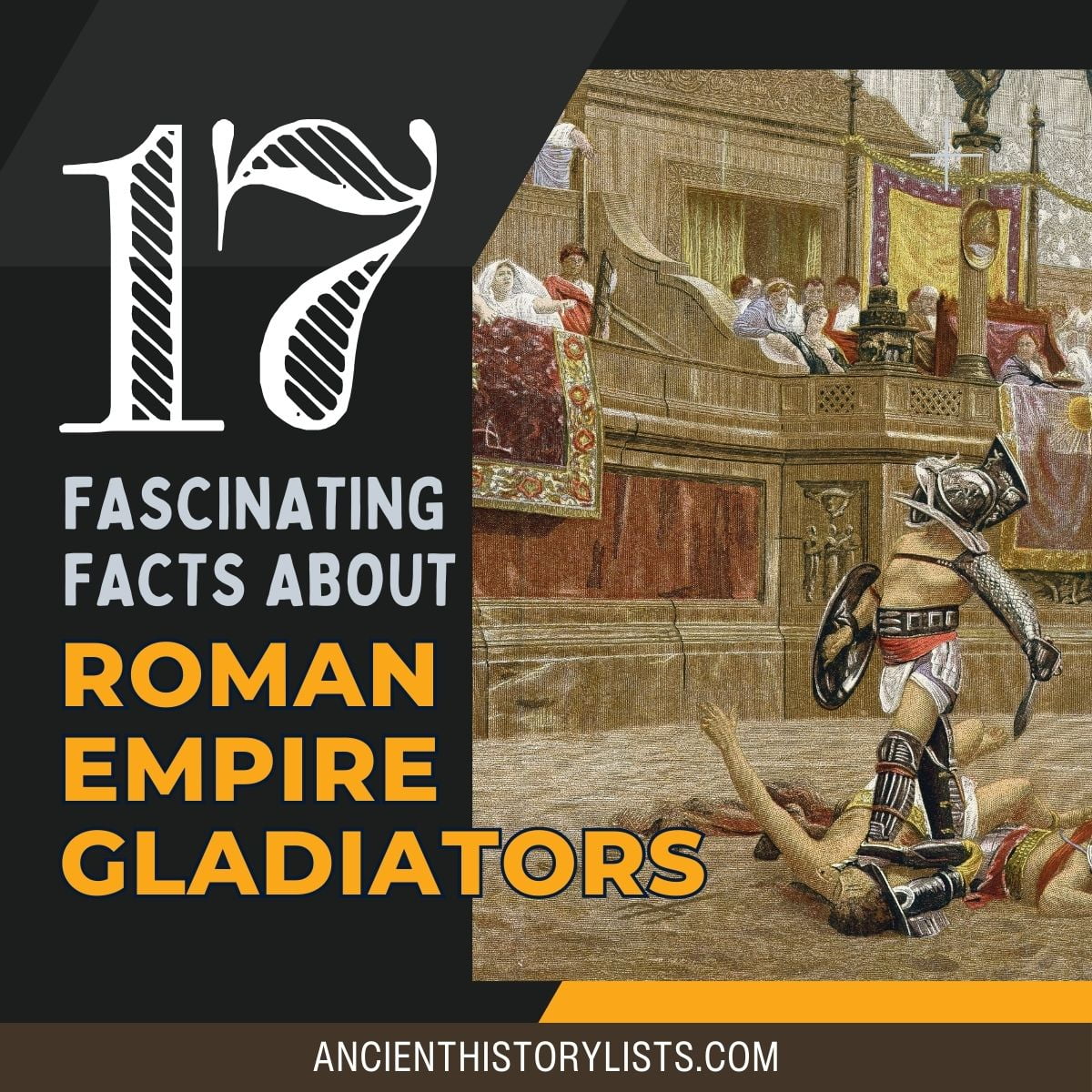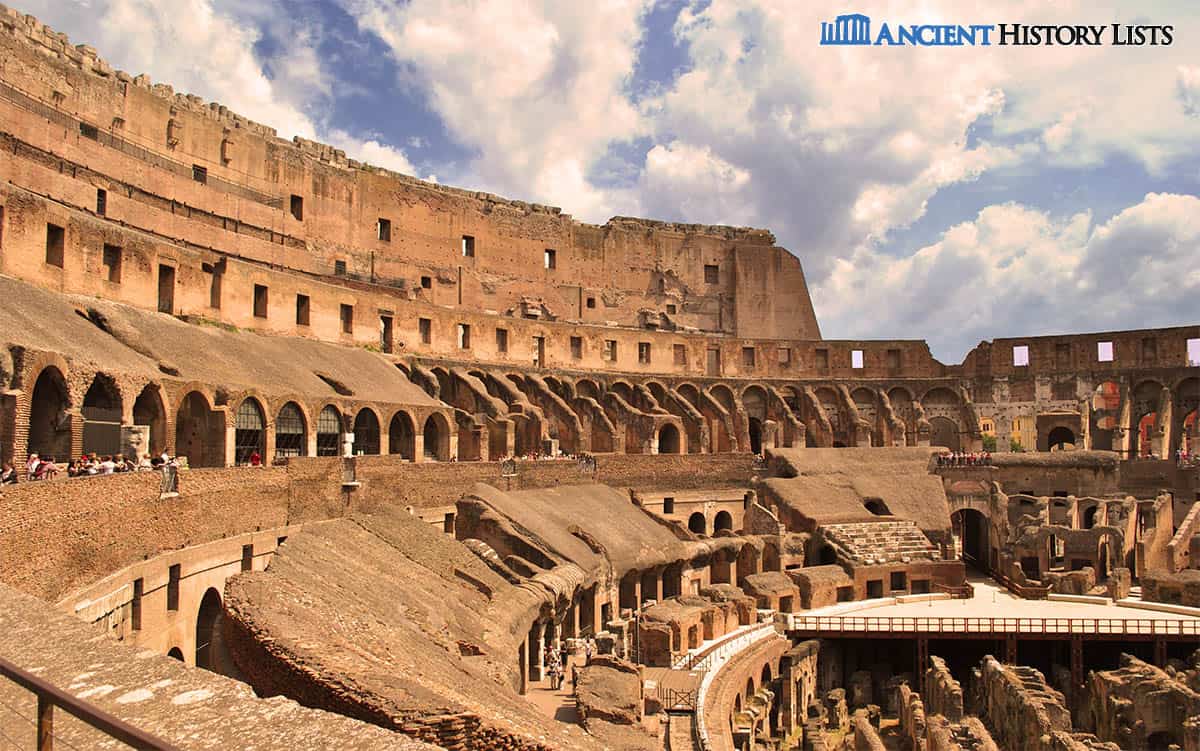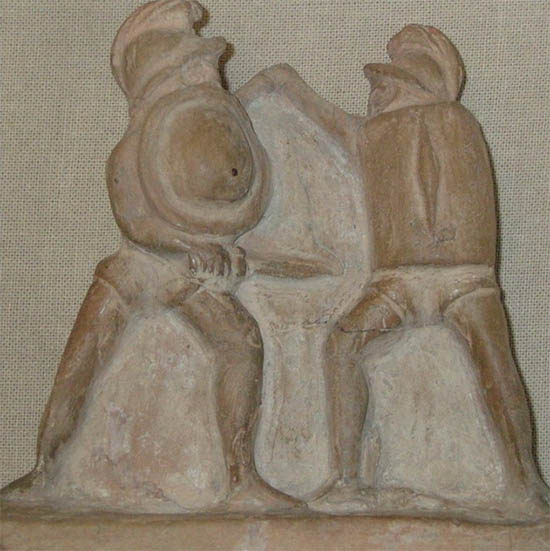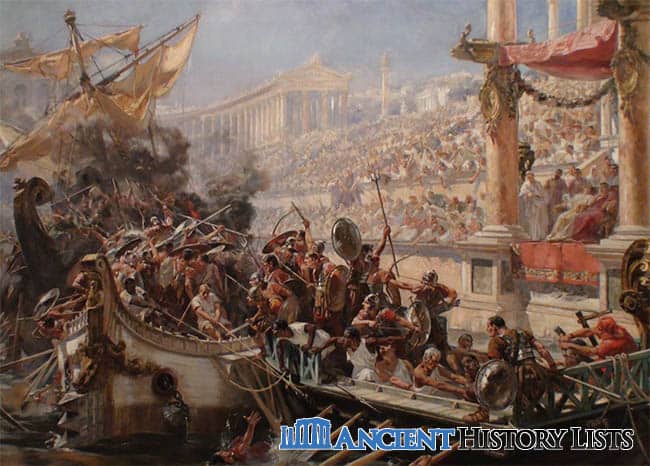Gladiators were Roman warriors who fought solely for the entertainment of the masses. Some would fight with weapons while others would simply wrestle it out.
The fights were held in arenas called colosseums, with each arena able to host more than 50,000 spectators at a time. The events were enthusiastically attended and were held on a grand scale.
They were violent, and popular with both the rich and the poor, with gladiators often attaining celebrity status after a win. Many gladiator-themed movies and dramas tell us of the nature of these fights, but not all of them are historically accurate.

Here are the top 17 fascinating facts about Roman gladiators:
1. Gladiatorial Events Replaced Munera Events
It is believed that munera events were the precursors of gladiatorial events. Munera events began in 264 BC when the two sons of a nobleman named Brutus organized a fight to take place in the marketplace in honor of their father’s death. Similar events followed, with slaves acting as the fighters. One such battle took place in 174 BC in which a record-breaking 74 fighters participated over a period of three days.
Munera spectacles evolved into events called venatio where wild and exotic animals were fought by a different class of gladiator called venatores. Each venatore would be equipped with weapons specifically designed for hunting. Venatio battles were separate from gladiatorial events and involved the hunting and killing of exotic animals like tigers, lions, and rare birds for the purpose of entertaining the masses.
As the Roman Empire grew, the enthusiasm for such events increased. The elite would organize such events on a smaller scale at parties, and they also became popular as funeral celebrations. Not all citizens enjoyed the bloodthirsty nature of these events. During one incident, which occurred in the reign of Tiberius, several townspeople stopped a funeral procession in protest, and Tiberius was forced to call on the army to quell the unrest.
2. Events Were Held in Arenas

Because of the popularity of such events, specialized venues called colosseums were created to house them, and munera battles eventually gave way to gladiator games. Approximately 186 amphitheaters were built across the Roman Empire, made from wood and sand.
The archaeologist and architect Jean Claude Golvin also believes that there is evidence of a further 86 archaeological sites which could have been colosseums.
The huge popularity of these events led to many arenas exceeding their capacity. An example of this was in Fidenae when the entire arena collapsed during a gladiator fight, leading to the death of at least 20,000 spectators.
3. Hoplomachi – Professional Fighters

While the munera spectacles were rough battles in which slaves fought each other with little or no weaponry, a new class of fighter soon began to emerge. These warriors were called hoplomachi, and they had distinct fighting skills.
The hoplomachi would wear steel armor and earned a fierce reputation due to their bloodthirsty fighting style. In fact, the hoplomachi are the gladiators you most often see in historical dramas and movies.
They were highly skilled warriors whose weapons included a small sword called the gladius. The hoplomachi’s sole purpose was to entertain the crowd, and their battles would range from single duels to staged spectacles.
The staged duels were a welcome change to the more usual bloody battles. Even though they also involved bloodshed, the hoplomachi would prolong the battle by attacking their opponents more slowly, and the battle would end when an opponent’s blood spilt on to the sand.
4. Gladiators Were Slaves
The original munera spectacles involved slaves fighting one another, and gladiators were originally slaves who were sold by their owners in some of Rome’s biggest slave markets. Women were also sold as slaves and also found work as gladiators. The gladiator ranks were further made up by criminals or prisoners who had been captured during Roman battles.
Several free men also became gladiators, attracted by the fame and celebrity. Their reasons could also have been due to a wish to escape other personal problems. In fact, it was estimated that more than 20 percent of the trainee gladiators who attended the ludi gladiatori, or gladiator school, were free men from Roman society.
No matter how popular a gladiator became, he never rose above the level of a prostitute in Roman society, and the word “gladiator” was a popular term of abuse. However, their treatment in society did not reflect their popularity, and their fans increased after each spectacle.
Romans became so obsessed with gladiators that they even painted their names on the city walls and hailed them as celebrities. Gladiator merchandise was popular especially amongst Roman women. For example, flakes of gladiators’ skin, bottles of their sweat, and ornaments colored with their blood were sold as aphrodisiacs and love potions.
5. The Noxii
As well as the hoplomachi and the venatores, there was a third kind of gladiator known as the noxii who were forced into the arena against their will. The noxii were dangerous criminals such as robbers and murderers from all across the empire. They were viewed as expendable fighters who were expected to die in the arena.
On entering the arena, the noxii had to make an announcement in front of the emperor: Ave Caesar, morituri te salutant! which translates as “Before we die we must salute the emperor.”
After the announcement, the battle would commence and usually involved one noxii fighting another until one of them was dead. Some gladiatorial events also involved a noxii fighting against the postulati who were skilled fighters like the hoplomachi and were armed with maces.
6. The Gladiator’s Oath
The gladiators had an oath which stated: Uri, vinciri, verberari, ferroque necari which translates as “I am willing to experience torture through fire, through captivity, through assault, and through murder by the sword.” They had to recite this oath when they first entered the arena.
The men who became gladiators through choice were given the opportunity to leave the career through the payment of a certain amount to the lanista (the man responsible for the health and wellbeing of the gladiators).
A fear of death in the arena would sometimes overpower the gladiators and they would attempt suicide inside their cells. This was highly unprofitable for the lanistae so they would hire special guards to keep an eye on the gladiators to prevent it.
7. The Gladiators’ Diet
Gladiators who rose to popularity after a victory were well taken care of by the professional staff of the ludi gladiatori, or gladiator school. The school was surrounded by high walls, and sharp weapons were prohibited within the school itself.
There were doctors on hand to provide treatment in case of injury on the training ground. The training schools also had nutritionists who would create balanced diets for the trainee gladiators. For example, food like barley was included in their diets as it helped to reduce the accumulation of fat in the arteries.
8. A Roman Gladiator Battle
The gladiator fights in the colosseums all had a theatrical aspect and were not a true representation of the normal way of combat. Despite popular myths that these battles were primarily concerned with bloodshed and gore, in actual fact, the gladiators would wear decorated armor to appear exotic, and all battles were fought in a choreographed style with props to prolong the fight and make it more entertaining. However, in the end, even the theatrical aspect of the gladiator fight could not disguise its final outcome of severe injury and death.
9. Naval Combat

Following on from the grand theatrical displays of the gladiatorial battles, the Romans soon developed a new form of battle called the naumachia or naval battle. According to historians, this theatrical form of naval combat was invented by Julius Caesar, and the first battle was conducted in a manmade lake near the Field of Mars, a military parade ground.
After the lake was filled with water, it could accommodate 16 large manned warships. Each ship had approximately 2,000 prisoners aboard who would fight among themselves while aboard the ship.
People would gather in huge numbers to view these spectacles and it is believed that a battle held at the Fucine Lake attracted more than 500,000 people. These events were guarded by armed men to maintain order and security in and around the arena.
10. Survival Rates
What do we know about the survival rates for gladiators? Almost all munera fights would result severe injury, and in the early days of the Roman Empire, there was a rule that if a fighter lost the battle and was injured, he would bleed to death inside the arena. But this law changed when Augustus Caesar came to the throne and introduced the rule that if a gladiator demonstrated valor during the battle, he would often get a pardon.
These practices helped to reduce the number of casualties and also helped to carve out new social values for gladiators. The great historian George Ville studied 200 battles from Caesar’s reign, and he could only find 19 duels where the gladiators died. However, after Caesar, the number of deaths increased and a gladiator died or was mortally wounded in every second or third battle that took place.
11. Female Gladiators
While Roman enthusiasm remained high for gladiator battles, audiences were always looking for new and exciting developments to keep the thrill alive. One solution to this was a female gladiator class called the Amazones. Watching women fighting like their male counterparts was new and exciting for spectators and kept the popularity of the fights alive.
The Amazones have been documented in works by several Roman historians such as Tacitus, Martial, and Suetonius. Amazones have also been depicted in Roman art, shown fighting in only loincloths and without helmets.
12. Roman Emperors Would Mimic Gladiators
There were several Roman emperors such as Commodus, Hadrian, Caligula, and Titus who were so fascinated by the gladiators that they would imitate them in the arenas themselves.
In the movie Gladiator, Emperor Commodus enters the arena and stages a battle against another gladiator. This was because he considered himself a god and wanted people to love him and compare him to Hercules. He even had statues of himself looking like Hercules placed all over the city which substantiate this myth and make him memorable. He would enter the battle arena dressed as Hercules and would kill slaves and animals to amuse himself as much as the audience.
13. Gladiators and Animals

Exotic animals were hugely popular among the Romans because they were not only beautiful but also very rare. Organizers would arrange fights between these animals, creating a magnificent spectacle for the audience. Since the animals were expensive, they would usually belong to the emperor, and battles between them would only take place on special occasions.
There were special gladiators called bestiarii who were professionals in training and fighting animals. Exotic animals would be hunted and killed in a variety of ways by gladiators called venatores, or they were used to kill Christians in front of a crowd of spectators. For each event, the organizers would charge hefty amounts per head and grand arrangements would be made.
Only the elite and wealthy Romans, as well as the emperor, could afford such events, and sometimes they were allowed to participate themselves, acting out the hunts in the arena with the help of the venatores.
During one such historical spectacle, over 9,000 exotic animals including hyenas, elephants, tigers, and lions were killed over a period of 100 days to inaugurate the Colosseum. One event dating back to 240 AD also included the hunting and killing of a white rhinoceros and hippopotamus.
The animals used for these fights were very expensive, and the trade for exotic animals grew with the popularity of these events. Due to this, many exotic breeds like the Eurasian lynx and the European white horse became extinct. Not all animals were destined to die in the arena, however, and the bestiarii would also train them for circus events.
14. Gladiators Ranked According to Fighting Skills
To enhance the excitement of the gladiator fights, a ranking system was introduced in which gladiators were classified into different categories. The most popular kinds were the retiarius, secutor, and murmillo.
Though the retiarius were brave warriors, they were still prone to injury as they were only armed with a net and a trident. In the arena, the retiarius would mostly fight the secutor who was armed with a helmet, shield, and sword.
The murmillos were more ferocious than the secutors and they were heavily armed. The provocator, on the other hand, wore full metal body armor and fought with a sword. Another class of gladiator was the hoplomachus and they fought with small daggers and shields.
Other classes of gladiators included the essedarius, who rode and fought on chariots, the dimacherius, who were armed with only two daggers, and the laquerius, who were similar to the retiarius and used a lasso instead of a net. Lastly, the most extraordinary kind was the andabatus who fought on horseback and wore helmets to cover their faces.
15. Gladiators’ Trade Unions
Gladiators were usually slaves belonging to the event organizers who had bought them from flourishing slave markets. Since they were bought for the sole purpose of fighting, there was no guarantee they would get a decent burial.
The solution was gladiators’ trade unions called collegia. Each collegium had its own leaders as well as gods whom they worshipped. Each gladiator would pay a membership payment which would ensure that a fallen gladiator would get a proper burial.
The union also ensured that the gladiator’s family would get some sort of compensation for their loss. However, if a gladiator could not afford to be a member of the collegia, his body would be fed to the animals or would be thrown in the river.
16. Spectators Never Used the Thumbs-Up Sign
The thumbs-up or thumbs-down gestures were not used by spectators to determine a gladiator’s fate. The decision to put a gladiator to death was not taken by the victor either, but instead by the highest authority present at the games.
The senior-most authority would consult with the emperor and the crowd and then make the final decision himself using either the thumbs-up or thumbs-down in front of the gladiator.
17. Not all Gladiators Were Slaves
The belief that all Roman gladiators were slaves is not true. Gladiators were often warriors who were captured during battle or were criminals accused of robbery and murder. After they were captured, they were sent to the gladiatorial training schools or, in the case of serious criminals, were sent directly to the arena for battle.
Some gladiators, however, were free Roman citizens who could withdraw from the profession at any time, but they often chose to remain due to the good pay. Along with good pay came fame and popularity, and free citizens who became gladiators enjoyed a high standard of living and a good diet. They also received proper medical care.
Free gladiators had access to other benefits which were not given to the common gladiators. The free gladiators could eat and speak whenever they wanted and were allowed to visit their families.